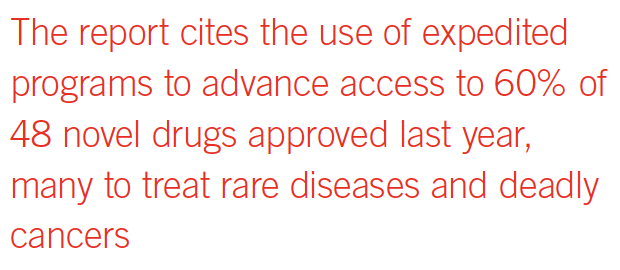The Risks and Rewards of Expedited Review
Pharmaceutical Executive
Weighing new strategies to accelerate biomedical product development.
With more new drugs and biologics gaining FDA approval based on accelerated research and review strategies, concerns have emerged about whether such innovations raise added risk for long-term product safety and efficacy. FDA officials maintain that they are not compromising the agency’s traditional “gold standard” for testing new medical products, and that it should utilize opportunities to efficiently address
Jill Wechsler

unmet medical needs of very ill patients.
An added benefit of FDA flexibility in clinical trial design and speedy reviews may be to reduce the cost of drug development, which could translate into less expensive treatments for patients. So far, though, many critical new drugs have set high launch prices despite expedited FDA vetting, clouding the sense of gain from these regulatory innovations and maintaining support for drug price control legislation.
In a report on Innovation in Drug Approvals of 2019, the Center for Drug Evaluation and Research (CDER) outlines an impressive record for expediting development and oversight of important new drugs last year. The report cites the use of expedited programs to advance access to 60% of 48 novel drugs approved last year, many to treat rare diseases and deadly cancers.1 While last year’s approval numbers for new molecular entities (NMEs) fall below FDA’s record 59 approvals in 2018, the latest list includes numerous first-in-class therapies and advances in care across a range of conditions, from heart disease, macular degeneration, osteoporosis, and migraine, to sickle cell disease, Parkinson’s, multiple sclerosis, and blood disorders. The report also cites multiple approvals of indications for expanded uses and additional patient populations, as well as new dosage forms for already marketed medicines.
These gains reflect a more efficient and predictable review process at CDER, as demonstrated by its success in meeting all user fee goals for timely assessments, reviewing 90% of applications in the first review cycle,

and approving nearly 70% of new drugs in advance of other countries.
The report points out that initiatives by sponsors in developing more targeted therapies for vulnerable patient populations, often based on genetic characteristics, benefit from the agency’s increased use of innovative and accelerated review procedures in recent years.
But while highlighting such gains in expedited drug development and review, CDER Director Janet Woodcock emphasizes that the agency’s “high standards for safety and efficacy have remained unchanged.” This responds to some fears that speedy approvals based on limited clinical studies raise risks related to long-term safety and efficacy. Woodcock states that the agency is maintaining approval policies while also utilizing innovative methods and new regulatory tools to bring “a wide range of new drugs to patients in need.”2
More flexibility?
Accelerated strategies for biomedical product development have advanced through new guidances on a range of methods and policies for streamlining clinical studies and updating FDA policies. These include increased reliance on real-world data gleaned from electronic medical records, particularly for documenting additional indications of a medicine, for developing natural history studies, and for advancing gene therapies. A final guidance on Adaptive Design Clinical Trials for Drugs and Biologics, issued in November, sets out key principles for designing, conducting, and reporting results of investigations utilizing Bayesian adaptive studies and other methods.3
A particularly notable move is FDA’s recent decision to revisit the controversial issue of when and how only one clinical trial may provide sufficient evidence to support approval of a new drug. The topic has been hotly debated for more than 20 years and now headed for further examination, as outlined in a December draft guidance on “Demonstrating Substantial Evidence of Effectiveness for Human Drugs and Biologics.”4
Federal law indicates that sponsors should conduct at least two randomized, blinded, placebo-controlled clinical trials to document drug efficacy, and that’s still FDA’s basic approach. But “there are circumstances where evidence generated using a variety of clinical trial designs, endpoints, and statistical methodology can support effectiveness,” commented FDA Principal Deputy Commissioner Amy Abernethy in announcing this new policy review.5
Agency officials explain that studies with concurrent, active, and historical controls may be appropriate in certain situations, such as testing treatments for rare conditions-in addition to utilizing the gold standard randomized controlled trial (RCT).
At the same time it is advancing accelerated research policies, FDA is taking steps to better monitor the safety and performance of both investigational therapies and approved drugs on the market. One initiative has established a new system for sponsors to report electronically adverse events involving study participants to more effectively track safety signals that occur during clinical trials. Recent legislation, moreover, authorizes the agency to request post-marketing studies to address questions about a new drug’s long-term effectiveness, in addition to safety issues. This added oversight may help reassure the research community that FDA has the tools to detect problems with expedited treatments, while also speeding new therapies to market based on fairly limited clinical experience.
Jill Wechsler is Pharmaceutical Executive’s Washington Correspondent. She can be reached at jillwechsler7@gmail.com
References

Addressing Disparities in Psoriasis Trials: Takeda's Strategies for Inclusivity in Clinical Research
April 14th 2025LaShell Robinson, Head of Global Feasibility and Trial Equity at Takeda, speaks about the company's strategies to engage patients in underrepresented populations in its phase III psoriasis trials.
Merck’s Oral TLR7/8 Inhibitor Reduces Disease Activity in Cutaneous, Systemic Lupus
May 21st 2025Results from the Phase II WILLOW trial show that enpatoran achieved a statistically significant dose-response and clinically meaningful reduction in disease activity in cutaneous and systemic lupus erythematosus with active rash.

.png&w=3840&q=75)

.png&w=3840&q=75)



.png&w=3840&q=75)



.png&w=3840&q=75)


















